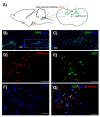The Effect of DREADD Activation of Leptin Receptor Positive Neurons in the Nucleus of the Solitary Tract on Sleep Disordered Breathing
- PMID: 34201760
- PMCID: PMC8269100
- DOI: 10.3390/ijms22136742
The Effect of DREADD Activation of Leptin Receptor Positive Neurons in the Nucleus of the Solitary Tract on Sleep Disordered Breathing
Abstract
Obstructive sleep apnea (OSA) is recurrent obstruction of the upper airway due to the loss of upper airway muscle tone during sleep. OSA is highly prevalent, especially in obesity. There is no pharmacotherapy for OSA. Previous studies have demonstrated the role of leptin, an adipose-tissue-produced hormone, as a potent respiratory stimulant. Leptin signaling via a long functional isoform of leptin receptor, LEPRb, in the nucleus of the solitary tract (NTS), has been implicated in control of breathing. We hypothesized that leptin acts on LEPRb positive neurons in the NTS to increase ventilation and maintain upper airway patency during sleep in obese mice. We expressed designer receptors exclusively activated by designer drugs (DREADD) selectively in the LEPRb positive neurons of the NTS of Leprb-Cre-GFP mice with diet-induced obesity (DIO) and examined the effect of DREADD ligand, J60, on tongue muscle activity and breathing during sleep. J60 was a potent activator of LEPRb positive NTS neurons, but did not stimulate breathing or upper airway muscles during NREM and REM sleep. We conclude that, in DIO mice, the stimulating effects of leptin on breathing during sleep are independent of LEPRb signaling in the NTS.
Keywords: chemogenetics; obstructive sleep apnea; upper airway dysfunction.
Conflict of interest statement
The authors declare no conflict of interest.
Figures







Similar articles
-
Leptin signaling in the dorsomedial hypothalamus couples breathing and metabolism in obesity.Cell Rep. 2023 Dec 26;42(12):113512. doi: 10.1016/j.celrep.2023.113512. Epub 2023 Nov 30. Cell Rep. 2023. PMID: 38039129 Free PMC article.
-
Designer Receptors Exclusively Activated by Designer Drugs Approach to Treatment of Sleep-disordered Breathing.Am J Respir Crit Care Med. 2021 Jan 1;203(1):102-110. doi: 10.1164/rccm.202002-0321OC. Am J Respir Crit Care Med. 2021. PMID: 32673075 Free PMC article.
-
Leptin Sensitizes NTS Neurons to Vagal Input by Increasing Postsynaptic NMDA Receptor Currents.J Neurosci. 2020 Sep 9;40(37):7054-7064. doi: 10.1523/JNEUROSCI.1865-19.2020. Epub 2020 Aug 19. J Neurosci. 2020. PMID: 32817248 Free PMC article.
-
Leptin acts in the carotid bodies to increase minute ventilation during wakefulness and sleep and augment the hypoxic ventilatory response.J Physiol. 2019 Jan;597(1):151-172. doi: 10.1113/JP276900. Epub 2018 Nov 29. J Physiol. 2019. PMID: 30285278 Free PMC article.
-
Intranasal Leptin Relieves Sleep-disordered Breathing in Mice with Diet-induced Obesity.Am J Respir Crit Care Med. 2019 Mar 15;199(6):773-783. doi: 10.1164/rccm.201805-0879OC. Am J Respir Crit Care Med. 2019. PMID: 30309268 Free PMC article.
Cited by
-
The efficacy of intranasal leptin for opioid-induced respiratory depression depends on sex and obesity state.Front Physiol. 2023 Dec 13;14:1320151. doi: 10.3389/fphys.2023.1320151. eCollection 2023. Front Physiol. 2023. PMID: 38162827 Free PMC article.
-
Detection of central and obstructive sleep apneas in mice: A new surgical and recording protocol.PLoS One. 2025 Mar 28;20(3):e0320650. doi: 10.1371/journal.pone.0320650. eCollection 2025. PLoS One. 2025. PMID: 40153464 Free PMC article.
-
Targeting melanocortin 4 receptor to treat sleep-disordered breathing in mice.J Clin Invest. 2025 Apr 15;135(12):e177823. doi: 10.1172/JCI177823. eCollection 2025 Jun 16. J Clin Invest. 2025. PMID: 40232848 Free PMC article.
-
The effect of brain serotonin deficiency on breathing is magnified by age.Physiol Rep. 2022 May;10(10):e15245. doi: 10.14814/phy2.15245. Physiol Rep. 2022. PMID: 35581741 Free PMC article.
-
Leptin signaling in the dorsomedial hypothalamus couples breathing and metabolism in obesity.Cell Rep. 2023 Dec 26;42(12):113512. doi: 10.1016/j.celrep.2023.113512. Epub 2023 Nov 30. Cell Rep. 2023. PMID: 38039129 Free PMC article.
References
-
- Heinzer R., Vat S., Marques-Vidal P., Marti-Soler H., Andries D., Tobback N., Mooser V., Preisig M., Malhotra A., Waeber G., et al. Prevalence of Sleep-Disordered Breathing in the General Population: The HypnoLaus Study. Lancet Respir. Med. 2015;3:310–318. doi: 10.1016/S2213-2600(15)00043-0. - DOI - PMC - PubMed
MeSH terms
Substances
Grants and funding
LinkOut - more resources
Full Text Sources
Medical
Molecular Biology Databases
Miscellaneous

